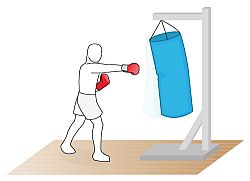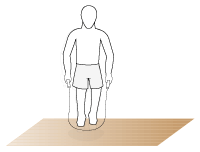Boxers Training Regime
One of the most physically demanding sports in the world, boxing necessitates a varied training regime, which allows the boxer to build up the fitness, techniques, agility, footwork and coordination required in the ring.
Shadowboxing
Shadowboxing is a common part of a boxer’s training regime, allowing the boxer to prepare their muscles at the beginning of a training session before they engage in more intensive forms of exercise. In shadowboxing the boxer does not require a partner but works on their own, often visualising a specific partner as a way of mentally preparing for a future fight.
Instead of practicing in the ring, the boxer works in front of a mirror, throwing punches in front of them as a way of getting into a fighting rhythm and identifying techniques to be worked on during the rest of the session. There are two different styles of shadowboxing: the long method and the short method. Using the long method, the boxer practices jabs and straight shots shuffling their feet to rock their body backwards and forwards. Alternatively, the short method is a way of practicing close body shots, with the boxer using a side-to-side motion to move the body from left to right in order to practice the technique of slipping short punches.
Bag Training

Bag Training
To learn how to throw jabs and punches and to improve anaerobic conditioning, boxers engage in bag training using various kinds of bags depending on the type of attack they are working on.
- The double end bag – Anchored to the floor and ceiling by elastic materials, the double end bag is a light round bag, used to practice throwing accurate jabs and punches to a moving target.
- The heavy bag – The largest of all the bags, the heavy bag is suspended by chains or thick ropes from a fixed point and is used for working on powerful punches and combination strikes.
- The maize bag – Filled with maize, the boxer uses the maize bag for light punches in order to practice head motion as a way of avoiding an opponent’s attack.
- The speed bag – The smallest type of bag, the speed bag is full of air and fixed at the top to a rebound platform. The aim of the speed bag is to allow the boxer to practice keeping their hands up in front of their face during a fight, as well as to improve coordination and speed.
- The pedestal bag (also known as the tower bag) – Unlike the other types of bags, the pedestal bag is not suspended from the ceiling but stands on a weighted pedestal. Like the heavy bag it is used to practice powerful punches and, specifically, uppercut punches which aim at the opponent’s head and upper part of the body.
- The body opponent bag – Shaped as a body, the body opponent bag is made of synthetic materials such as form and is usually fixed to a pedestal, allowing the boxer to practice punches on a simulated human opponent.
Sparring
Whilst the majority of a boxer’s training regime occurs outside of the ring, sparring is a necessary means to practice punches and defence techniques against an opponent as well as helping to build up the boxer’s fitness levels. The intention of sparring is not for a boxer to beat their opponent but instead two opponents work together on a routine which allows them to practice particular techniques.
In training, boxers use special gloves which have more padding than gloves used in competition, along with a head-guard, groin-guard and gum-shield in order to prevent risk of serious injury. An alternative form of sparring is known as body sparring which does not allow boxers to hit their opponent’s on their head.
Jump rope training

Jump Rope
Jump rope training or skipping is a common part of a boxer’s training regime, used to improve agility, footwork, coordination, speed and endurance. For jump rope training, boxers use a rope of approximately 8-10 feet long, holding one end in each hand and jumping over the rope for several 3-minute ‘rounds’, in order to get used to the endurance required in each round of a fight. There are three main ways of using the jump rope for training:
- Running in place – The easiest way to use the rope, this requires the boxer to run on the spot, moving the rope over their head and lifting their feet over the rope as it comes down in front of the body.
- Double unders – A more advanced and strenuous way of using the rope, this requires the boxer to keep their feet together and jump with both feet at a time, jumping once for every two turns of the rope.
- Criss cross – The criss cross can be applied to either of the above styles of using the jump rope, adding a more challenging dimension to the basic skipping steps. To perform the criss cross, the boxer is required to cross their arms (and the rope) as the rope passes down in front of the body, jumping through the loop that is formed and uncrossing the arms during the next rotation.
Aerobic/ Anaerobic exercises
Like most sports, boxing is an aerobic sport requiring high levels of fitness and endurance, which means that a large part of the boxer’s training regime consists of aerobic and cardiovascular routines. Exercises such as sit ups, press ups, crunches, pull ups, squat thrusts and star jumps are a crucial part of training, helping the boxer build up the muscle and endurance required of them in the ring. Boxers usually complete several circuits of specified exercises at the end of a training regime in order to improve mobility, strength and stamina. Jogging and track races are also a good way of building up the aerobic energy demanded in the ring.
As well as requiring high levels of aerobic energy and endurance, the power and strength demanded in the ring requires the boxer to have high anaerobic energy levels. A good way to build up anaerobic energy is through plyometric exercises. Plyometric exercises utilise explosive bursts of energy and are used to improve the boxer’s muscle contractions and reaction times in order to allow them to respond quickly and powerfully to an opponent’s punch. Plyometric exercises include depth jumps, throws, short sprinting exercises and abdominal exercises using a medicine ball. Bag work can also be classified as a form of plyometric exercise because it uses the muscles powerfully for a short amount of time.
